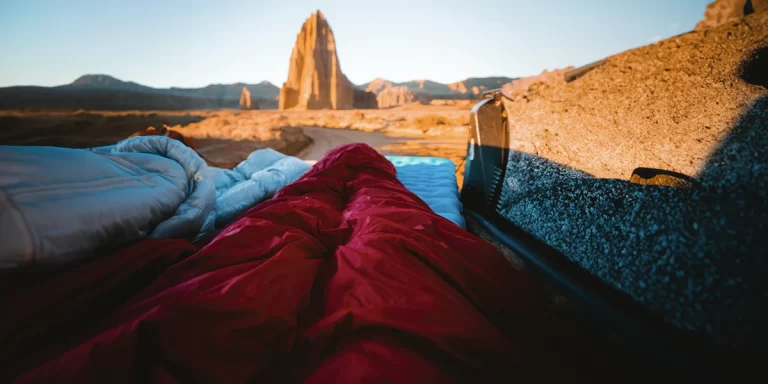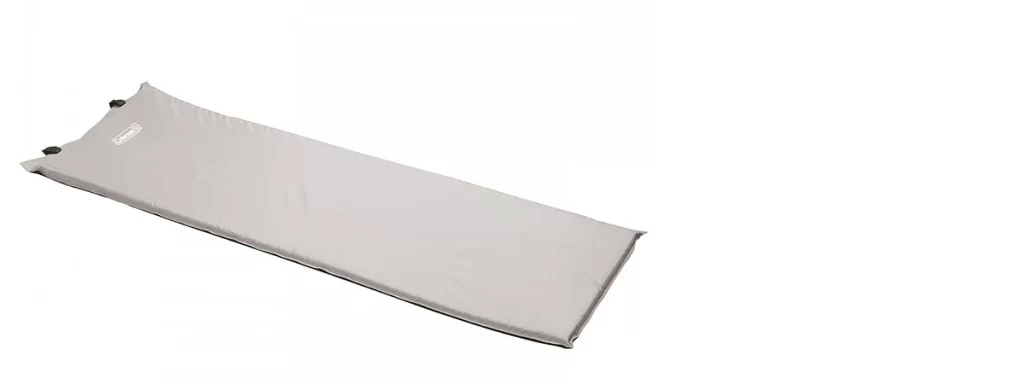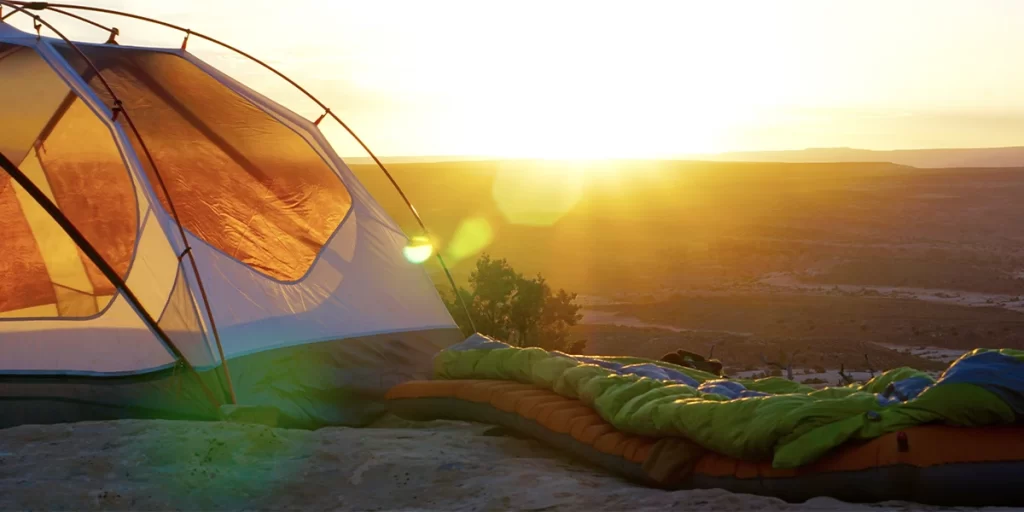

For outdoor lovers, campers, and backpackers, a night on uneven ground can spoil the adventure. That’s where the unsung hero, the sleeping pad, comes in.
Discovering how to choose a sleeping pad is crucial for a rejuvenating night’s sleep instead of discomfort and cold.
This post explores sleeping pad types, R-values, and durability. We’ll conclude by applying what we’ve covered to help you pick the right pad.
Interested? Let’s dive in!
Sleeping pads come in three primary categories, each with its unique features and benefits. Let’s explore these types in detail:
Air pads are immensely popular in camping and backpacking for their comfort, versatility, and various styles, from lightweight to luxurious. Modern versions often include insulation and reflective materials for added warmth.

Pros:
Cons:
Self-inflating pads combine open-cell foam insulation with air. When you open the valve, the foam expands and draws in air automatically. These pads come in variations suitable for both backpacking and car camping, offering a balance between comfort, insulation, and convenience.

Pros:
Cons:

Closed-cell foam pads are the rugged workhorses of sleeping pads. Composed of dense foam filled with tiny closed air cells, these pads are known for their durability and consistent insulation performance. They are often rolled up or folded in a Z formation for easy transport.
Pros:
Cons:

When it comes to choosing a sleeping pad, one critical factor to consider is its R-Value – a measure of a sleeping pad’s ability to insulate and resist heat transfer.
R-Value indicates how well the pad can keep you warm by preventing your body heat from escaping into the ground. The higher the R-Value, the better the pad’s insulation.
Here’s why it matters:
Understanding R-Value can be simplified into these basic guidelines:
Remember that your pad’s R-Value is just one part of your overall sleep system. Other factors, such as your sleeping bag’s insulation and the type of shelter you use, also play vital roles in keeping you warm.

When venturing into the great outdoors, durability is a paramount concern for any gear, and sleeping pads are no exception. Your sleeping pad is your buffer against the rugged terrain beneath you, and its longevity can significantly impact your outdoor experience.
The durability of a sleeping pad is closely tied to the materials used in its construction. Manufacturers often specify the denier of the materials, with a higher denier indicating thicker and more robust fabric. Here’s a breakdown of common materials and their durability:
Almost all sleeping pads come with a patch kit for quick DIY repairs in the field. Familiarize yourself with the patching process before heading out on your adventure.
Additionally, many manufacturers offer warranties for their products. Check the warranty terms before purchasing your sleeping pad to understand what damages are covered and for how long.
Now, let’s turn our knowledge into actionable information for you to choose the best sleeping pad. Here’s what should be on your checklist before deciding:
To make lifer a bit easier for you, here are some popular ultralight air pads among outdoor enthusiasts:
| Brand / Model | Weight oz (g) | R-Value | Price Level |
|---|---|---|---|
| Sea to Summit Ether Light XT | 17.28 (490) | 3.2 | $$$ |
| Thermarest NeoAir XLite NXT | 13.05 (370) | 4.5 | $$$ |
| Exped Ultra 5R Sleeping Mat | 20.7 (587) | 4.8 | $$$ |
| Nemo Tensor Regular Mummy Sleeping Mat | 15.2 (431) | 4.2 | $$ |
| Sea to Summit Ultralight Insulated Sleeping Mat | 17.6 (500) | 3.1 | $$ |
In the world of outdoor adventures, the choice of a sleeping pad often goes unnoticed, yet it can profoundly affect your experience. It’s the difference between a night of comfort and warmth and one filled with discomfort and cold.
This guide has delved into the realm of sleeping pads, unraveling their mysteries and explaining the science of R-values. We’ve shown how your sleep system, comfort, and warmth are interconnected with your choice of sleeping pad.
From the diverse types of sleeping pads to the crucial concept of R-values, we’ve covered it all. Whether you prefer the plush comfort of air pads, the versatility of self-inflating pads, or the rugged durability of closed-cell foam pads.
When it comes to durability, we’ve shared insights into the materials and valve systems that matter. And remember, patch kits and warranties are your allies in extending your pad’s life.
So, choose wisely, venture boldly, and may your nights in the great outdoors be filled with dreams as magnificent as the landscapes you explore.
Check out our TOP 5 Guides to find the lightest sleeping pads and foam pads on the market.
When hiking, it’s essential to have a complete sleep system, which typically includes a lightweight, insulated sleeping pad or mat, a warm sleeping bag or quilt, and a suitable shelter like a tent or hammock. This system ensures insulation, comfort, and protection from the ground, enabling a restful night’s sleep on the trail.
When choosing a sleeping pad, it’s important to pick the appropriate length, width, and thickness to suit your body size, sleeping style, and comfort needs. A general rule of thumb is to opt for a pad length that aligns with your height – regular size for sleepers under 6 feet tall or long/extra-long size for taller people. Also consider the pad’s width based on if you sleep solo, with a partner, or need extra room to change positions. Thickness ranges from 1 inch for minimalist pads up to 4 inches for ultra-cushioned comfort
Side sleepers require a sleeping pad that provides pressure relief at the shoulders, hips, and knees while maintaining adequate warmth and insulation. Look for pads with extra thickness from 2.5-4 inches to cushion pressure points like the hips and shoulders. Mummy shaped pads are ideal for side sleepers since the tapered design perfectly contours to your body’s natural position. Self-inflating pads tend to be more comfortable thanks to their integrated foam and adjustable firmness. Air pads with vertical baffles help prevent the “bottoming out” sensation.